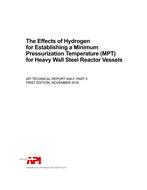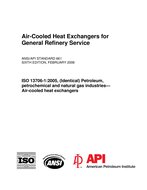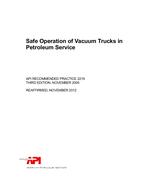
API TR 934-F Part 4
Click here to purchase
Hydrogen, dissolved in the thick wall of a steel pressure vessel during steady-state operation in elevated temperature, high-pressure H2, can cause both slow-subcritical crack advance as well as unstable-catastrophic fracture during shutdown and startup. This behavior is defined in Section 2. It follows that modern fracture-mechanics assessments of the minimum pressurization temperature (MPT) and fitness for service (FFS) must include the deleterious effect of H on both subcritical and unstable internal hydrogen assisted cracking (IHAC). Two approaches are in draft stage to develop standard procedures that address this need; an API 934-F recommended practice and a WRC Bulletin 562 basis for ASME/API 579.
The objective of this technical report is to establish the technical basis necessary to enable and validate these best practices for quantifying the effects of hydrogen on (a) the MPT, and (b) FFS of a thick wall hydroprocessing reactor. The approach entails two parts.
Part 1 emphasizes critical assessment and collection of two primary H-cracking properties; the threshold stress intensity for the onset of subcritical H cracking under slow-rising stress intensity (KIH), and the critical stress intensity for the onset of unstable-catastrophic cleavage-like crack growth promoted by H (KIC-H).
Part 2 focuses on the methods to use these data to quantitatively predict an MPT that precludes H cracking during shutdown and startup. The sum of these two parts, validated-extensive IHAC data, and science-based engineering analysis, establishes a single technical basis that can be consistently incorporated in API 934-F and API/ASME 579 recommended practices to control H cracking.
Section 3 documents extensive KIH and KIC-H data that conservatively characterize IHAC in 2¼Cr-1Mo weld metal and base plate. The effects of critical variables are documented, including the degree of temper embrittlement in terms of the FATT after thermal exposure, total H concentration, and stressing temperature. KIH data are aggregated for three classes of steel purity. Section 3 also presents results from a recent API-sponsored study that established the material-property data relevant to MPT and FFS assessment for V-modified Cr-Mo steel.
Section 4 develops the technical basis for MPT and FFS assessments using the fracture-mechanics data presented in Section 3. The effects of H concentration, temperature, and cracked body geometry on KIH are effectively modeled based on the fundamental concept of crack tip H concentration similitude.
Section 5 lays out the proposed architecture for the MPT determination, which is defined by both stable IHAC and unstable fast fracture criteria. There are three levels of assessment for each criterion. Level 1 constitutes the simplest and most conservative method, while Level 3 is the most complex procedure and is the least conservative.
Product Details
- Edition:
- 1st
- Published:
- 11/01/2018
- Number of Pages:
- 112
- File Size:
- 1 file , 4.5 MB
- Product Code(s):
- C934F401, C934F401, C934F401
- Note:
- This product is unavailable in Cuba, Iran, North Korea, Syria

